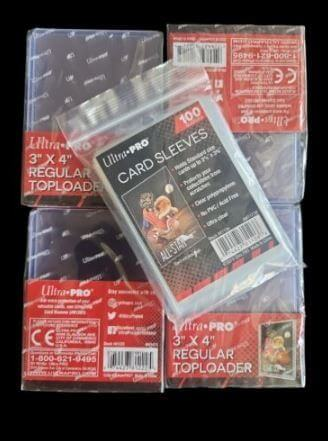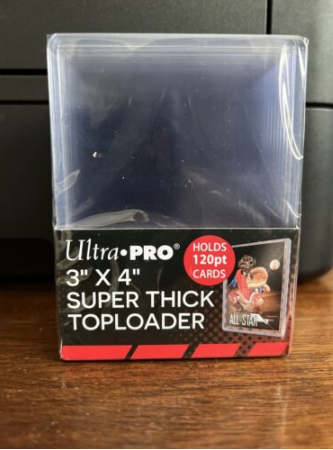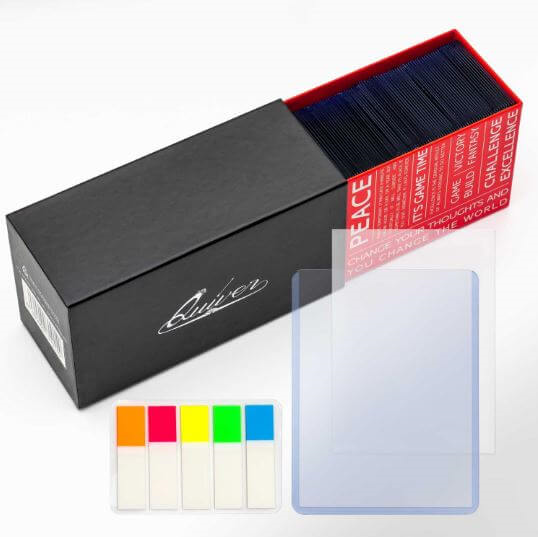Much like you do after a successful third date, your sports cards need protection. We don't like to see our cards sustain any damage on the most basic level. We get them to admire; even the most minor imperfection can be upsetting. But since sports cards are now a big business, damage can cost you much money. Take a look at the difference in value between a PSA 9 and 10. The latter are generally worth about three times as much as the former. And the difference can be the most minor discoloration or chipping. Something that could have been easily prevented by a, you guessed it, top loader.
But not all top loaders are made equally. Some are made so poorly that they can cause preventable damage to your cards. There are also different sizes and styles of protectors. It can be particularly difficult to find one for cards that are not of standard size. Cards that are bigger, smaller, or thicker than usual can be a real challenge to protect. But worry not; we are here to guide you on this voyage of protection.
Oh, and we won't waste your time on where to buy top loaders. I am sure you are aware of Amazon and eBay at this point!

What Is A Top Loader?
No, it isn't a washing machine that loads from the top instead of the front. Although, those are pretty convenient since the bending can be murder on your knees. Instead, they are rigid holders for your cards that are enclosed on three sides. However, the top is open, allowing you to slip your beloved collectible into the hilt. And since you load it from the top, people refer to this piece of protective equipment as a top loader.
The standard top holder consists of a front, and back sheet of Polyvinyl chloride (PVC), which Wikipedia assures me is the world's third-most widely produced synthetic plastic polymer. They are attached to each other by strips of spacer plastic.
When Should You Use A Top Loader?
That is a personal decision based on several factors. The size of your collection is one issue. Some people have a relatively small collection of cards they treasure. In that case, you will want to put all of the non-slabbed cards in top loaders. If you have thousands of cards, as many of us do, using top loaders on all your cards or even a significant subset may be impractical. After all, the cost adds up, and it's also tedious to place thousands of cards in a top loader. The short and sweet answer is to place anything with emotional or significant monetary value (actual or potential) in a top loader. In cases of exceptionally high value, though, you might want to consider slabbing the cards instead.
But there are cases when you should probably avoid top holders altogether. Some cards are made of flimsy foil, especially those 1990s monstrosities. The PVC can make them come apart. And autos do better in slabs than in top loaders, especially in the long run.
The Pros And Cons Of Different Types Of Top Loaders
In most cases, the type of Top Loader you want to purchase will be determined by the card size. However, you will still need to account for the brand and style. There are also other things to take into account, such as the rigidity of the protection and its cost. Therefore, we will look into some of these differences for you.
Top Holders Versus Card Savers
Some collectors use the terms top holders and card savers interchangeably. However, they are not the same thing. Although the principle is the same, both offer more comprehensive protection than a penny sleeve; they differ in rigidity. A card holder is not quite as tough as a top loader and therefore has more give. In other words, it is significantly bendier. Another difference is the shape. Card holders are taller than the cards. Meanwhile, top loaders are about the same length.
Advantages Of Top Holders Versus Card Savers
The main difference you will notice is in the process of placing the card within the protector. When you put a card in your top holder, assuming it is the correct size, it will simply slide in up to the hilt. But a card saver requires more shimmying and angling. It is fair to say that placing a card inside a card saver is more difficult.
The difference in this regard isn't particularly significant. But it isn't meaningless. The more of a struggle it is to insert the card, the more likely you are to damage it in the process. Edges, and mainly corners, are susceptible to that. But it's essential to add that you may be using a top loader's wrong type and size if there is too much resistance. So, don't try to fight through too much resistance.
Moving Versus Keeping Cards At Home
What makes the card holder harder for insertion purposes is also an advantage. You will generally find that your cards move around far more in the protective case of the top loader. After all, it is less of a tight fit. Meanwhile, the card saver will stop the card from moving. Indeed, the weakness of a top loader comes to the fore if you drop it on the floor with enough impact. In those cases, the card may come tumbling out and sustain damage. Therefore, a card saver is probably better if you move your collection, look at them, or show them to people often.
But if you are keeping your cards at home, the more rigid top loader has some significant advantages. If you sell cards on eBay and other e-commerce platforms, you will find that top loaders tend to be more transparent and are, therefore, more camera friendly.
Buying and Selling Sports Cards Online: A Comprehensive Guide
If you drop something heavy on a card protected by a top loader, it will protect the item better. And there is one final reason most people store their cards in top loaders. The bigger the card is in its holder, the more challenging it can be to find a storage solution. Most boxes for cards will not hold the larger card holders. Therefore, top loaders remain the most popular and convenient option for home storage.
What Is Better For Mailing?
First things first, when you mail a card, make sure to protect it with not just a card saver or top loader but also place it between two pieces of cardboard. You will also want to place it in a top holder for the added toughness. But remember that the cards are more likely to move around in a top loader. Therefore, you will want to double up on penny sleeves. If you prefer to mail the item in a card protector, consider doubling up on the cardboard to compensate for the lost toughness.

Which Is The Best Brand For Your Top Loaders?
There are two major brands for card protection purposes. Ultra Pro is by far the most popular and widely available producer of top loaders. There is nothing remarkable about them, but they are tried and true. You know they will protect your cards, help display them clearly, and will not discolor your cards.
The closest competition to Ultra Pro on the market is BCW. The PVC for this brand is high quality and probably a bit better than their better-known rivals. But they are a bit smaller and, therefore, less versatile. So you won't be able to fit those thicker cards in them.
You will do fine with either of the big brands. However, Quiver is probably better overall, even if it is a less-known brand. They provide a firm grip on cards, so you will likely experience fewer cases of cards falling out. In addition, they are less likely to show fingerprints and grease. That is great if you are less than careful about handling your collection right after scarfing down some Five Guys.
Which Size Of Top Loaders Should You Get?
The standard sports card, at least since 1957, measures at 2 1/2″ X 3 1/2″ inches. The best top loaders for that size are the good old reliable 3″ X 4″. That continues to be the standard for base cards and standard sets. But you have smaller sets, unique cards, and bigger ones. However, the most common now is thicker cards. Especially if they contain patches or other types of memorabilia. Finally, you have vintage cards that can vary wildly in size because there was no standardization in the olden days.
Top Loader Width
Therefore, there are several sizes of top loaders on the market. Here are the main ones:
- 3″ X 4″: The standard. It fits most cards, even ones that are slightly bigger or smaller than the standard. Therefore, the vast majority of top loaders on the market are of this type.
- 1 7/16″ X 2 5/8″: The classic tobacco cards of the early 20th century were smaller than the modern standard. A bit shorter and more slender. The best-known cards of this kind are the T206s and E90-1 American Caramel cards. So, you will want to put them in these. But honestly, if you have a card from this era, it's probably worth grading and slabbing.
- 6″ X 9″: works for those bigger cards, anything measuring up to 5 X 9 or so.
Top Loader Thickness
While width has become more standardized, the thickness of cards is often a bigger problem. Therefore, top loaders come in a variety of sizes measured in points. A point is a unit of 0.001 inches. The standard card fits nicely into a unit with 20 points of thickness. However, that does not suit every card.
The most common Top Loader sizes available are:
- 20 points: This top holder is suitable for all cards with a standard thickness, like, say, the base cards in Topps flagship. It will likely work for most inserts and other cards as well.
- 35 points: Some of the Panini Prizm and Panini Hoops cards are a big thicker and require a 35 point top loader. So if you collect those, you may want to get 35s instead of the 20s.
- 55 points: A 55 is your best option for those thicker auto cards that do not include memorabilia. If you are a big autograph collector, you will want a box of these.
- 75 points and 100 points: These are the best holders for RPAs and other memorabilia cards. A 75 will easily contain the standard ones. But the bigger and more elaborate RPAs will need a 100.
- 120 points and 130 points: if you are ripping National Treasures or Flawless, these are the sizes you will need. The others may damage these cards, which are often worth quite a bit.
- 180 points and 360 points: you will rarely need these unless it is some sort of mega-sized novelty card.

Note On Sleeving Your Cards
In most cases, putting your cards in a penny sleeve or equivalent is wise before placing them inside a top loader. You do this for three reasons. First, so the edges do not get frayed through friction against the PVC. But also, because (as we have discussed) the card can come out of the top loader, and you want to minimize the damage if that occurs. Third, the penny sleeve will protect your card from dust and dirt. Finally, remember that the PVC can erode the color on the card over time, especially when exposed to high temperatures.
Final Word On How To Find The Perfect Top Loaders For Your Sports Cards
Whatever card you have, there is a top loader that is the right size and made for your needs. But keep in mind that it isn't the best solution for long-term storage because of the chemicals in PVC. Therefore, consider slabbing your high-ticket items instead. Grading your sport cards may be the key to skyrocket their value. However, they are a wonderful solution for temporarily storing and transferring cards.
